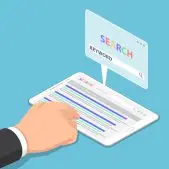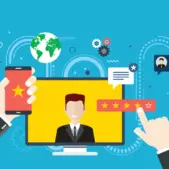eCommerce has emerged as a critical point of focus for growth-minded B2B companies. In fact, a 2022 report highlights the rapid transformation of the B2B buyer journey. Digital-only sales are surging among B2B buyers; about two-thirds of businesses now rely on digital-first engagement with vendors.
The COVID-19 pandemic was the spark, shifting the B2B transaction model away from its traditional focus on in-person channels. Buyers have since become increasingly familiar and comfortable with online purchasing. For instance, 35% of B2B buyers are willing to spend $500,000 or more on a single digital purchase. Another 15% feel comfortable with digital transactions valued at $1 million or more.
But given the rapid pace of change, many B2B companies have yet to update their digital presence. This guide examines B2B websites from a user experience (UX) perspective. We also highlight strategies that businesses can use to execute a successful redesign amid changing buyer practices and preferences.

Limitations of Old Websites on the Buyer Journey
Some B2B companies have been slow to react to the changing buyer journey. Specifically, they overlook the importance of their websites. In their minds, the company’s digital presence is secondary to a continued focus on traditional in-person sales channels.
Most B2B buyers now complete their own research before they contact a vendor. As a result, websites have become critical gateways for attracting customers. Yet too many old websites take a “contact us to learn more” approach to drive prospects to salespeople for product details. When buyers can’t get the information they want easily, customer friction is a common result. This often translates into a lost opportunity for your business.
Overcoming website limitations requires an advanced understanding of the modern B2B buyer journey. To this end, redesigns should prioritize:
- Self-Service Options: A recent Shopify study found that 86% of B2B buyers prefer to deal with vendors that offer self-service options. Failing to properly support customer self-service can cause B2B companies to miss out on this massive market.
- Faster Loading Speeds: Slow website and page loading times lead to high bounce rates. Businesses should aim for page loading times of three seconds or less. To achieve this, websites should cache pages, minimize user redirects, use more efficient coding, and compress visual media to the smallest usable size.
- Visually Appealing and Logical Layouts: Websites should be professional, user-friendly, and easy to navigate. They should also have clear page hierarchies. Don’t prematurely direct users into sales funnels. Instead, emphasize useful information that addresses visitors’ common problems or questions.
UpTop Perspective
A site without personalization speaks to everyone and no one at the same time.
The Role Website Redesign Plays in an Ever-Changing Corporate Landscape
Technology tends to lead changes in consumer behavior, and the B2B landscape is no exception. Personalized marketing based on user data, market segmentation, and bespoke experiences have become increasingly important in the B2B world.
Effective approaches in these critical areas can help B2B companies more effectively communicate with and appeal to high-value accounts. This can potentially lead to profitable long-term relationships.
B2B companies can also attract high-value, long-term business by configuring their websites to include detailed and specific information in digestible formats. B2B products and services are often highly specialized. As such, B2B websites must strike a careful balance between explaining product and service specifications in detail without overloading the user with technical information.
Most importantly, website design must account for the unique nature of the B2B buyer journey. Multiple people with differing perspectives and needs typically participate in B2B purchasing decisions. So, websites should make product and service research easy, intuitive, comprehensive, and responsive to various devices and viewpoints.

Changing Buyer Personas
When considering your business growth strategy, remember that changing demographics have a rising impact on the B2B buyer journey. Traditional representations of B2B buyers characterize decision-makers as older executives at the top of their organizations. But even in 2015, younger digital natives were playing an increasing role in product and service research and purchasing decisions. As a result, B2C trends like peer-to-peer reviews and pricing comparisons are having a growing effect on B2B buyer behaviors.
The emerging generation of B2B buyers prefer to lead their own research independently. Often, they won’t interact with any sales personnel until the final stages of the buyer journey. So, B2B websites should make it easy for researchers and buyers to:
- Explore and compare product or service features in deep detail
- Engage with reliable and trustworthy peer-driven experiences and reviews
- Try specific products or services to ensure compatibility with buyer needs before finalizing a purchase
In addition, B2B companies should update their buyer personas to reflect these changing realities and gain a competitive advantage in a changing landscape.
UpTop Perspective
B2B buying groups are growing in size, especially for larger organizations. It’s imperative to provide information and resources that are relevant to each persona in that group to shorten the sales cycle and reduce friction in the buying process.
A Look at the Consumer Decision-Making Process
User-sourced data represents an increasingly critical component of the modern B2B buyer journey. Not only should B2B websites support user-guided research, but they should also decrease their reliance on sales personnel and make it easier for potential customers to trial products and services. In addition, digital resources should support the kind of seamless, convenient, and frictionless cross-platform experience that’s so important to digital natives.
The B2B buyer journey typically begins with a specific problem that requires a cost-effective and productive solution. In this context, businesses can use the following strategies to position themselves as worthwhile partners:
- Demonstrate Expertise: Website content should display an advanced and precise understanding of the problems and challenges faced by potential customers. Businesses can then curate their content to demonstrate their insights into those challenges and the specific ways in which their products and services solve them.
- Provide Examples of Managed Solutions: B2B companies that service customers in multiple industries can further differentiate their content to focus on market-specific managed solutions. This tends to be most effective when businesses configure their content to showcase tangible, real-life successes.
- Offer Complete Details: B2B companies should strive to support user-guided research to the greatest possible extent. Present essential specifications and pricing details in an overview format. Make it easy for users to access deeper and more detailed information on their own.

What to Consider When Tackling a Redesign
B2B businesses often underprioritize their websites. They also frequently underfund website development and redesigns, leading to UX deficiencies that can easily result in lost sales.
Thorough UX research can make a major difference, which businesses can support by prioritizing the following design principles and website features. Websites that emphasize these elements are much more likely to drive conversions and boost sales.
- Minimalist, clutter-free navigation that flows from a strong, clear homepage design
- Complete, easily accessible and readable sitemaps
- Consistent branding and visual design elements that contribute to a seamless user experience
- Mobile-friendly design for cross-device users
- More emphasis on information that addresses every aspect of the buyer journey, and less emphasis on pushing users into sales funnels
In addition, businesses often need to test specific aspects of their redesigns before pushing their new sites to the live internet. So, it’s essential to use wireframes and prototypes to conduct UX testing ahead of a formal launch.
Leverage Expert Guidance to Lead the B2B Buyer Journey
The B2B buyer journey is changing. Businesses that adapt put themselves in a better position to succeed in the emerging environment. Investing in a comprehensive website redesign can pay dividends.
We specialize in creating the kind of optimized user experiences that drive engagement and boost conversions. To modernize your B2B website experience, contact our team at UpTop today.


